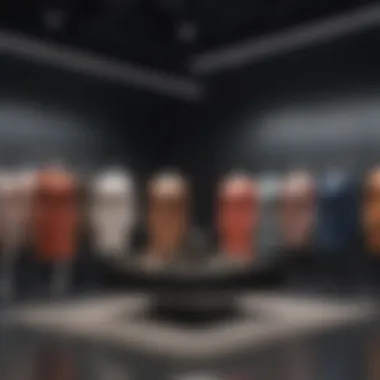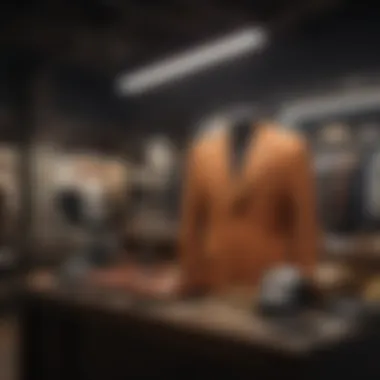The Real Real Clothing Store: A Comprehensive Analysis


Intro
The Real Real clothing store operates within the niche of luxury consignment. The brand's innovative approach appeals to a range of consumers. This trend in secondhand fashion has become more than a passing fad. Rather, it signifies a shift in consumer priorities—where sustainability and authenticity gain prominence. In this analysis, we will explore the unique business model of The Real Real, the market dynamics it navigates, and the psychology behind the growing acceptance of pre-owned luxury items.
Market Overview
Current Market Sentiment
The sentiment around the secondhand luxury market appears to be positive. Consumers are increasingly aware of their environmental footprint. Many perceive buying secondhand as a sustainable and responsible choice. The Real Real capitalizes on this sentiment by offering a curated selection of authenticated luxury items—fostering trust in its shoppers.
Major Indices Performance
While The Real Real does not directly influence major stock indices, the luxury retail sector shows underlying strength. Companies in this space often recover faster from economic downturns compared to other retail sectors. This resilience indicates that consumer interest in luxury goods remains robust, which benefits platforms like The Real Real.
Economic Indicators Analysis
Economic indicators such as disposable income and consumer confidence index suggest a steady recovery post-pandemic. Increased disposable income allows consumers to explore higher-end products, including secondhand luxury. This reflects in the sales figures of consignment stores like The Real Real, pointing toward a thriving segment within retail.
The Business Model of The Real Real
The Real Real operates on a consignment model. This implies that sellers send their luxury items to the platform, and The Real Real manages the sale. The brand takes a commission from the sale price. This setup not only mitigates risks compared to traditional retail but also allows for diverse inventory that appeals to a broad audience.
Psychology of Secondhand Fashion
The psychology behind purchasing secondhand items varies among consumers. For some, it is about saving money; for others, it is about unique finds. Moreover, the shift towards appreciating pre-owned luxury stems from developing values around sustainability and ethical consumption.
The Real Real plays on these psychological trends, encouraging consumers to view secondhand shopping as not just economical but socially responsible as well. They articulate this message through marketing campaigns, creating an emotional connection that resonates with consumers.
“The Real Real is redefining the luxury shopping experience by making it accessible while being planet-friendly.”
As we delve deeper into the specific dynamics of The Real Real, we will explore the challenges it faces, the opportunities within the market, and how these factors intertwine with consumer psychology.
Ending
The journey of The Real Real is illustrative of broader trends within the fashion industry. It reflects changing attitudes towards luxury, sustainability, and consumer choices. As the market evolves, understanding these dynamics offers valuable insights for both consumers and investors alike.
Overview of The Real Real
The Real Real represents a significant development in the luxury consignment market. This section examines how this company has positioned itself and the impact it has on both consumers and the fashion industry. Understanding the Real Real is crucial, as it illustrates the shift towards sustainable fashion and the changing consumer preferences towards secondhand items.
Founding and Evolution
The Real Real was founded in 2011 by Julie Wainwright. She envisioned a platform that would allow customers to buy and sell authenticated luxury consignment items. The concept emerged from a growing desire for sustainable shopping practices. Over the years, the company has evolved significantly. From its beginnings as an online-only platform, The Real Real expanded into physical retail locations, enhancing brand visibility and customer engagement.
The evolution also includes technological advancements. The Real Real uses various digital marketing strategies to attract its target audience, such as influencer collaborations and online advertising. The introduction of brick-and-mortar stores represents a blend of online convenience with the tactile experience many consumers still value.
Business Model and Revenue Streams


The Real Real operates on a consignment-based business model. Sellers send their luxury items to the company, which then authenticates and lists these products on its platform. The Real Real takes a commission from each sale, which varies depending on the value of the item.
Key revenue streams include:
- Commission on sales: Revenue primarily generated from selling luxury items.
- Membership fees: The Real Real offers premium membership options that provide benefits such as discounts and early access to sales.
- Retail sales: Physical stores contribute to revenue, appealing to customers who prefer in-person shopping experiences.
The company also leverages data analytics to refine its pricing strategy and optimize inventory management, ensuring a higher turnover rate and improved profit margins. As the demand for sustainable fashion rises, the Real Real’s model not only addresses consumer desires but also capitalizes on current market trends.
Market Position and Competitive Landscape
The market position and competitive landscape of The Real Real provide crucial insights into its functioning within the luxury consignment sector. Understanding these elements is essential for investors and stakeholders who are focused on evaluating business sustainability and market performance. Unique complexities exist in the luxury resale market due to its niche audience and evolving consumer trends.
Assessment of Market Share
The Real Real has carved a notable position in the luxury resale market. Its market share is influenced by various factors, including consumer preferences, trend shifts, and the overall growth of online shopping. The company primarily attracts affluent, environmentally conscious consumers. This demographic is increasingly realizing the value of secondhand luxury items.
- Current Market Share Estimates: The Real Real reportedly holds a significant share within the secondhand luxury sector. Various reports suggest that this figure could be around 20-30%.
- Growth Trajectory: The luxury consignment market is projected to grow significantly in the coming years. This growth is attributed to a rising awareness of sustainable practices in fashion.
- Demographic Insights: The consumer base comprises younger, wealthier individuals who often prefer unique items over conventional retail offerings. This preference positions The Real Real favorably against traditional retailers.
The market share assessment underlines the competitive advantages that The Real Real possesses. These include a reputable brand, a well-designed online platform, and a fine-tuned process for authentication of items, which ensures customer trust.
Key Competitors and Their Strategies
In analyzing the competitive landscape, it is vital to consider the primary contenders in luxury resale. Notable competitors include Vestiaire Collective, Poshmark, and Fashionphile. Each company has distinctive strategies aimed at capturing market share and appealing to specific consumer segments.
- Vestiaire Collective: This platform emphasizes community and curation. It appeals to users through a strong focus on trends and peer recommendations. Their strategy involves partnering with luxury fashion houses to offer exclusive items, thereby enhancing their brand reputation.
- Poshmark: Known for its social selling aspect, Poshmark utilizes a unique engagement strategy. Users can share listings and interact within a community, driving sales through social connections. This approach attracts a younger audience eager for a more interactive shopping experience.
- Fashionphile: They focus extensively on high-end luxury goods, particularly branded handbags. Their strategy relies on creating a sense of urgency through limited-time offers and exclusive sales.
The competitive strategies of these companies highlight the dynamics that shape the luxury resale market. The Real Real must navigate these challenges while simultaneously capitalizing on its strengths, such as its vast inventory and strong online presence.
Understanding the market position and competitive landscape of The Real Real is essential for investors seeking reliable opportunities in the evolving retail environment.
In summary, The Real Real's standing and strategies within the luxury resale sector reflect a complex interplay of market share dynamics and competitive positioning. By monitoring these factors, investors and stakeholders can make informed decisions that align with market trends and consumer expectations.
Consumer Behavior in Secondhand Fashion
Understanding consumer behavior in the realm of secondhand fashion is pivotal for grasping how The Real Real operates within this niche market. This section elucidates the choices and motivations that drive consumers toward secondhand options, highlighting the key elements that influence their purchasing patterns. The behavior of consumers reflects shifting societal values, particularly concerning sustainability, luxury, and individual expression.
Demographics of The Real Real Customers
The demographic profile of The Real Real’s customers reveals a diverse group that transcends traditional buyer segments.
- Age Range: Predominantly, customers are younger, with a significant percentage falling within the 25-45 age range. This group often values experiences over possessions and demonstrates a penchant for conscious buying.
- Income Levels: The Real Real attracts consumers from various income brackets, but there is a marked concentration among middle to upper-middle-class individuals. These customers are often looking for luxury items at a fraction of retail prices.
- Geographic Distribution: Urban areas showcase a higher concentration of consumers, influenced by the accessibility of secondhand luxury goods and a cultural trend toward sustainable fashion choices.
- Gender: Women tend to dominate the customer base, though an increasing number of men are engaging with secondhand luxury, signaling a shift in shopping habits.
Overall, understanding these demographics enables The Real Real to tailor marketing strategies that resonate deeply with their consumers.
Motivating Factors for Purchasing Secondhand
Several key motivations compel individuals to purchase from The Real Real and similar platforms. Recognizing these factors can provide insights into consumer preferences and behavior.
- Sustainability: Many consumers are becoming more environmentally conscious. Purchasing secondhand items reduces waste and carbon footprint, aligning shopping choices with personal values.
- Cost Effectiveness: Shoppers often seek luxury goods at a lower price point. The Real Real provides access to high-end brands without the weighty financial burden typically associated with new items.
- Unique Finds: Secondhand shopping offers the thrill of discovery. Customers enjoy hunting for rare and unique pieces that set them apart from mainstream fashion.
- High Quality: Luxury goods are frequently better made than fast-fashion alternatives. Consumers recognize the longevity and durability of items from brands such as Gucci and Louis Vuitton, which adds value to their secondhand purchases.


Ultimately, the motivations for purchasing secondhand extend beyond the tangible benefits. They often reflect a deeper identity and personal philosophy toward consumption and lifestyle choices.
In this evolving landscape, it is crucial to comprehend these elements and adapt strategies to meet consumer expectations effectively.
Sustainability Practices
Sustainability practices are a central component of The Real Real's business approach. As awareness of environmental issues rises, consumers increasingly demand responsible practices from the brands they support. Luxury resale is inherently linked with sustainability, as it promotes a circular economy. This involves reusing and repurposing goods, which reduces waste and curtails the need for new production resources. In this sense, The Real Real stands out in the retail landscape for its commitment to eco-friendly practices.
Environmental Impact of Luxury Resale
The environmental impact of luxury resale is significant. When consumers choose to buy pre-owned items, they help decrease the volume of textile waste. The fashion industry is one of the major contributors to global pollution. By extending the life-cycle of luxury products, platforms like The Real Real minimize the carbon footprint associated with manufacturing new goods.
Additionally, resale prevents items from ending up in landfills. According to a study, almost 92 million tons of textile waste is generated globally each year. Reselling luxury goods not only conserves resources but also fosters awareness about the importance of sustainability in fashion. This can lead to better decision-making among consumers, who may start to think critically about their purchases.
Corporate Responsibility Initiatives
The Real Real actively engages in corporate responsibility initiatives. One key focus is on ethical sourcing and transparency. By ensuring that every item sold is authentic and ethically sourced, The Real Real builds trust with its customers.
Another important initiative is its commitment to environmental stewardship. The company implements strategies to minimize its environmental footprint through various programs. These include recycling materials, implementing energy-efficient practices in logistics, and collaborating with partners who share the same sustainability goals.
Furthermore, The Real Real recognizes the need to educate both consumers and the industry about sustainable practices. By sharing insights about the impact of fast fashion and the benefits of secondhand shopping, it positions itself as a leader in the movement for a more sustainable fashion industry. This not only enhances customer loyalty but contributes to the broader dialogue surrounding sustainability in fashion.
Such initiatives are pivotal in adapting to changing consumer preferences and in fortifying the company’s market position in the luxury resale segment.
Authenticity and Trust
In the luxury resale market, the concepts of authenticity and trust are paramount. The Real Real thrives on creating a reputable platform that assures consumers of the quality and legitimacy of its products. Many customers who shop at The Real Real do so not only because of the allure of discounted luxury items but also due to the assurance that they are purchasing genuine products. When buyers feel confident in the authenticity of their purchases, they are more likely to engage repeatedly with the brand, enhancing customer loyalty.
Strategies for Ensuring Product Authenticity
To maintain the integrity of its offerings, The Real Real employs several strategies aimed at ensuring product authenticity. Here are some key elements:
- Expert Authentication: The company employs a team of experts who specialize in verifying the authenticity of luxury items. These experts have backgrounds in fashion and brand knowledge, allowing them to identify genuine products accurately.
- Detailed Listings: Each product is accompanied by detailed descriptions, including photographs that showcase unique identifying features. This transparency helps customers make informed decisions.
- User Reporting: The platform encourages customers to report any concerns about items that seem inauthentic. This adds an additional layer of accountability.
- Return Policy: The Real Real's return policy offers buyers the option to return any item that does not meet their expectations of quality or authenticity. This further instills trust among consumers.
By employing these strategies, The Real Real not only safeguards its reputation but also fosters a credible shopping environment that appeals to discerning luxury consumers.
Consumer Trust and Brand Reputation
Consumer trust plays a critical role in shaping brand reputation. For The Real Real, building and maintaining trust is essential for sustaining growth in an increasingly competitive market.
The company focuses on several factors to enhance trust:
- Transparency: The Real Real’s openness regarding its authentication process builds credibility. Shoppers can understand how their items are vetted, which reinforces confidence in their purchases.
- Customer Reviews: Highlighting customer feedback allows potential buyers to see the experiences of existing customers, thereby fostering community trust.
- Public Relations: The company's efforts in public relations also amplify its reputation. Engaging with media and influencers who share similar values toward sustainability and luxury fashion helps create a positive brand image.
- Community Engagement: By supporting charitable causes and sustainability initiatives,The Real Real creates goodwill that permeates its brand. This can significantly enhance consumer loyalty and reputability.
Technological Innovations
Technological innovations play a crucial role in the evolving landscape of the fashion resale market. The Real Real clothing store integrates advanced technology to enhance the consumer experience and streamline operations. The significance of these innovations lies in their ability to facilitate transactions, augment product authenticity, and provide insights into evolving market trends. This section explores how technology underpins the store's growth while reshaping consumer behavior in secondhand luxury fashion.
Role of E-commerce in Secondhand Sales


E-commerce serves as a backbone for The Real Real's business model. The platform enables buyers and sellers to connect in a seamless, user-friendly environment. The convenience of shopping from home appeals particularly to the modern consumer. It allows people to explore a vast range of luxury items without geographical limitations.
Furthermore, the use of digital payment systems ensures secure transactions. This level of security increases consumer confidence, which is vital for attracting first-time buyers. The Real Real also focuses on mobile optimization, recognizing that many shoppers turn to their smartphones for initial research and purchases. This emphasis helps capture a larger market share by making shopping accessible at any time.
Key Benefits of E-commerce for The Real Real:
- Global Reach: Expands the customer base beyond local markets.
- Customer Engagement: Provides an interactive platform for consumers to share experiences and reviews.
- Data Collection: Gathers important data on consumer preferences and behavior, which aids in inventory and sales strategy.
Use of Artificial Intelligence and Data Analytics
Artificial intelligence and data analytics represent cutting-edge tools that The Real Real employs to optimize various aspects of its operations. AI helps in personalizing the shopping experience. By analyzing user behavior, the website can recommend items tailored to individual preferences. This feature enhances customer satisfaction, potentially leading to increased sales.
Additionally, data analytics allows for stock optimization. Predictive analytics can forecast trends and determine the types of items that may be popular in the near future. This insight is critical for maintaining relevant inventory, ensuring that products align with consumer demands.
Moreover, AI can also assist in the authentication process. Machine learning algorithms can analyze product images and descriptions, identifying discrepancies that may suggest counterfeiting. This capability not only enhances product integrity but also solidifies consumer trust.
Challenges Facing The Real Real
Challenges that The Real Real encounters are important to understand. They shape the company's business strategies and impact its sustainability and growth. As the luxury resale model flourishes, it must also navigate complex market conditions and fierce competition. The subsequent sections delve deeper into these challenges, identifying key elements that could affect its future trajectory.
Market Volatility and Economic Factors
The Real Real's profitability is significantly influenced by market volatility. Economic shifts can lead to fluctuations in consumer spending, particularly in luxury markets. When the economy is in a downturn, consumers often cut back on luxury purchases. This can affect The Real Real since its business model relies on high-value items. Here are some specific factors to consider:
- Consumer Confidence: Changes in consumer sentiment can have direct results. If consumers feel uncertain about their financial situation, they may opt for more budget-friendly choices.
- Economic Indicators: Indicators such as unemployment rates and inflation rates can influence shopping behavior. High inflation might reduce disposable income, making consumers less willing to spend on luxury goods.
- Global Events: Events like pandemics, trade wars, or economic sanctions can also significantly affect luxury buying patterns.
The Real Real must adapt its strategies to cushion against these market fluctuations. It can consider diversifying its product offerings or enhancing marketing efforts to attract a wider customer base.
Competition from Fast Fashion and Traditional Retail
The booming presence of fast fashion poses a substantial challenge to The Real Real. Brands like Zara and H&M are known for their rapidly changing collections at accessible price points, which can divert attention away from secondhand luxury items. This offers both pros and cons in the competitive landscape:
- Price Sensitivity: Fast fashion tends to attract consumers who are price-sensitive. They often prioritize affordability over sustainability or luxury resale.
- Brand Loyalty: Established luxury brands may also pose competition, as they create emotional connections with their clients which can complicate The Real Real's target demographics.
- Market Trends: Fast fashion companies frequently capitalize on the latest trends, providing consumers with constant newness. This keeps shoppers engaged but can also disrupt the resale market.
The Real Real should focus on emphasizing the quality, sustainability, and exclusivity of its products. Highlighting the benefit of buying luxury items at a fraction of the cost can also create a compelling narrative for consumers considering resale options over fast fashion.
Success in today’s retail environment requires an understanding of both market volatility and competitive pressures. The Real Real's future may depend on how well it addresses these challenges and leverages opportunities within the secondhand fashion market.
Future Trends in Resale and Fashion Retail
The landscape of fashion retail is changing rapidly, particularly in the resale sector. The Real Real has positioned itself at the forefront of this shift, making it essential to understand the future trends that will shape this remarkable market. As consumer preferences evolve, so do the strategies and methods of engaging with secondhand luxury items. This section aims to explore significant predictions and implications for key stakeholders.
Predictions for the Luxury Resale Market
The luxury resale market is expected to witness notable growth in the coming years. Several factors will influence this trend:
- Increased Awareness of Sustainability: Consumers are becoming more environmentally conscious. Many prefer secondhand clothing over fast fashion, thus seeking ways to reduce their carbon footprint.
- Rise of Digital Platforms: The acceleration of e-commerce, spurred by advances in technology and shifts in consumer habits, means more shoppers will turn to online marketplaces. This creates opportunities for companies like The Real Real to capture a larger audience.
- Changing Consumer Demographics: Younger generations, particularly Millennials and Gen Z, show a preference for unique and vintage items. Their willingness to shop secondhand will contribute to market growth.
- Growth of Circular Fashion: The concept of circularity in fashion promotes recycling and reuse of garments. Luxury brands are increasingly adopting this model, thus expanding the market for resale.
"The luxury resale market is not just a trend. It reflects a shift towards more sustainable practices in fashion, appealing to a conscious consumer base."
Implications for Investors and Stakeholders
The evolving nature of the luxury resale market carries significant implications for investors and stakeholders involved in fashion retail. These implications include:
- Investment Opportunities: With the growth of the resale market, investments in companies like The Real Real might present advantageous opportunities for capital appreciation.
- Market Diversification: As the industry adapts, stakeholders should consider diversifying portfolios to include secondhand luxury goods. This can mitigate risks associated with traditional retail models impacted by economic shifts.
- Sustainability Initiatives: Stakeholders are encouraged to invest in sustainability initiatives within their companies. Enhancing a brand's commitment to eco-friendly practices can improve customer loyalty and attract environmentally conscious consumers.
- Enhanced Consumer Engagement: Understanding and adapting to consumer preferences is crucial. Companies must focus on building strong connections with their audience through engaging online platforms and personalized experiences.



